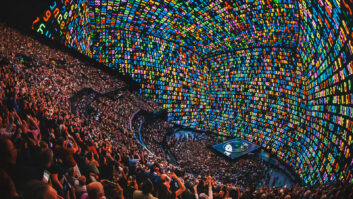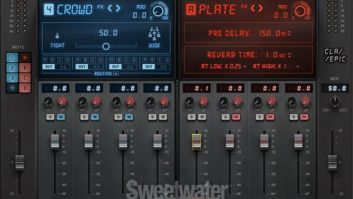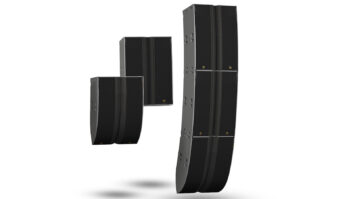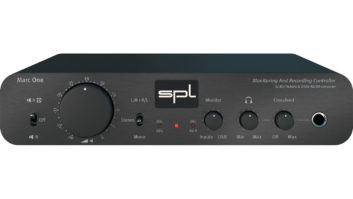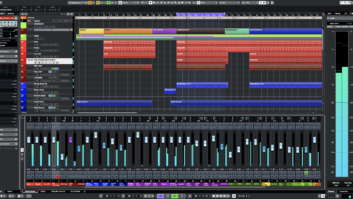Every Sunday, I scan the back page of The New York Times Arts and Leisure section for the J&R Music World ads. As a barometer of what’s popular, it covers everything from computers to DJ gear, headphones to home theater, iPods to eye-candy. Sadly, DVD-A and SACD players are under-represented. Sure, the hardware and software exists if you know where to look, and these are, after all, niche-market items geared toward audiophiles and home theater enthusiasts. This column is primarily about elevating awareness of universal DVD/SACD players (see the table) and encouraging audio professionals to take advantage of DVD-A as a format. But before I begin, I must make a few points.
Bullet 1: While DVD-A and SACD are capable of multichannel audio, the emphasis is on stereo reproduction. This is partly because a good stereo system is capable of providing a 3-D experience. Whether we’re talking about surround or stereo, Bullet 2 is the obstacle — getting regular people to sit down in the sweet spot to enjoy the fruits of our labors. Note: How SACD is converted from Direct Stream Digital (DSD) to the analog output jacks of a universal player is not a primary concern for the moment. Suffice to say that quality is likely to vary with the price of the unit. In addition, some players allow standard CDs to be up-sampled before D/A conversion. Here, too, you’ll get more for your money.
Bullet 2: The popularity of MP3s reflects a cultural shift toward music as wallpaper rather than serious listening. This reinforces Bullet 1, that in the short term, DVD-A could be a trickle-up consumer format, one that serves the obvious niche markets, including our own. Long term, we gotta figure out how to entice listeners.
Bullet 3: I will not be nibbling away at nuance except to point out some obvious flaws in the way invalid comparative judgments are made. The ability to truly discern the differences among various audio sources requires, quite literally, a level playing field. I do plan to devote a whole column on how to set up a “proper” A/B/X evaluation. But for now, the most important issue is that both of these formats exist, as each serves a useful purpose.
Compared to a CD, DVD-A has an enhanced feature set (including still and video images), while SACD is simply standard and high-resolution stereo and high-resolution surround. Unlike CD and DVD-A players, SACD players do not have digital outputs.
Bullet 4: A DVD-A can be just as easily and affordably burned as an audio CD. This is not an option with the SACD.
With these parameters set, let’s get to the real discussion.
BREAKING THE HABIT
As professionals, we sweat the details, meticulously tweaking the trees to create the most wonderful, bug-free forest possible. (Unless, of course, they’re really good- sounding bugs!) Outside of the lab, truth be told, while we may have certain minimum standards for playback, there are plenty of us who try to listen as consumers do.
The CD is like the Yamaha NS-10, a standard that represents one facet of the average playback system. No longer as flawed as it was once perceived to be, every aspect, from hardware to technique, has been scrutinized and improved so that the 44.1kHz/16-bit medium can fully realize its potential. Now only the “cheap reproducers” are the weakest link.
MONKEY “C”
That the high-resolution niche is such a small percentage of a larger, but shrinking, sonic market should not deter us from jumping onboard and sharing our environment with serious audio hobbyists. I’m not saying there’s gold in them thar niche hills, but at least audiophiles are listening. Think of it another way: High-resolution consumers are less likely to complain about relative level from one disc to another. It might be a way to get the Volume Wars’ monkey off our backs.
Excessive compression and peak limiting may be a form of artistic expression today, but it might also be responsible for turning off listeners in the long run. It literally collapses the sound stage down from three to two dimensions, and in doing so, it only makes the analogy of music as wallpaper more accurate. Car audio systems have become the lowest common denominator, greatly improved in response and power, and yet challenged by a dynamic range that is dictated by higher-than-average noise floor. It’s a pity that audio has been composed to emulate FM radio signal processing — yet another contributor to the downfall of high fidelity.
HANDS UP
In our midst are those who have issues with surround, thinking that it requires too much “fuss” to set up or that consumer playback systems are too unpredictable. While the latter is true, some progress has been made on both the consumer and professional sides of the equation in terms of addressing production technique. Surround is not a dominatrix; it can do your bidding, and you can use as many or as few channels as you’d like. I recently did a jazz trio project in which the front channels (left and right only) got the stereo mix, while the rear channels got an ambient stereo mic and a taste of reverb.
LESS CONFUSION, PLEASE!
My interest in high-resolution took off several years ago after DVD-A authoring became affordably possible via Minnetonka’s DiscWelder Steel ($495 list). Then last year, my mother-in-law accidentally purchased a Three Tenors Christmas SACD — one without the CD layer (duh!) — so I snagged it and bought her the CD-only version. CDs, DVDs and SACDs all look the same — so many formats now exist for the ubiquitous 12cm disc that manufacturers need to make it easier for consumers to play any and all.
SPREAD THE WORD
Because manufacturers are not likely to read this column, I’m hoping to turn y’all on. Spread the word to your customers by offering to burn them a DVD-A. They’ll share the sonics with friends and that will hopefully trigger a small chain reaction — increased universal DVD player sales will perhaps give manufacturers the hint. Meanwhile, as high-resolution audio is already being stored on hard drives, CDs and DVDs as data, why not use DVD-A for both archiving and client evaluation? Consider this: DAT trickled up from the consumer to the professional domains with the help of record company paranoia. That’s fortunately not the case with DVD-A, but I hope you’ll see its trickle-up potential.
BEWARE COMPARATIVE ANALYSIS
You may have noticed that I’ve not spoken a word about the actual sound quality of high-resolution audio. That’s partly because I believe that the most significant “bit” is in the hands of the producer, engineer and artist. Besides, if you’re not gonna sit in the sweet spot, what’s the point? But people do sit down to listen. When I get a moment to sit down, it can be an emotional experience. From Louis Armstrong to Frank Sinatra, Shawn Colvin to k.d. lang, The Beatles to Bjòrk, I have, on occasion, been moved to tears. I love when the music is so powerful that I momentarily forget about the technology.
On the other hand, people have told me about the stunning difference between, for example, the CD and SACD “layers” of otherwise identical material. When asked how the comparison was made, the response was disappointingly unscientific. To start, two identical players and discs should be playing side-by-side. Sony has a test SACD, part number TGZD 90005, that may be hard to get but would facilitate the setup process. It would also be helpful to speak with the mastering engineer.
The CD layer would require minimal processing — resampling and dithering — but that would still make for a fair comparison with the high-resolution layer. However, if dynamics processing were also used to make the CD layer comparable to other CDs, all bets are off. This was the case with Pink Floyd’s Dark Side of the Moon SACD as reviewed and analyzed by Jon Iverson and John Atkinson in the May and June 2003 issues of Stereophile. As it turns out, dynamics processing was applied to the CD layer. I became aware of this via reprint in the Boston Audio Society’s newsletter, the BAS Speaker.
LISTEN
That consumers seem content with MP3s is a cultural statement: Easy, portable music-as-wallpaper, which is fine for its intended purpose, but it’s not good ear-training. My mission is far more subversive than promoting high-resolution audio. While I have never been obsessed about kissing digital zero for fear of losing resolution, I believe that, by taking advantage of the DVD-A, we can collectively kick the “excessive dynamics processing” habit. Perhaps it is idealistic of me to think that if music production and recording could be made more inviting, then more people would take a moment to listen. But it’s worth trying.
Our country has been obsessed with the goal of constantly increasing productivity, a malady that’s spilling over into Europe to the point where their way of life is threatened. You’ve got to admit that a six-week vacation sounds like a pretty good idea. Granted, many of us work through holidays and don’t always get to take vacations, but perhaps we should all take a step back and think about increasing and appreciating the quality of life — and listening.
Eddie would like to thank David Glasser of Airshow Mastering for his SACD expertise and David Hadaway of the BAS Speaker for the tenacious pursuit of accurate comparative analysis.
Universal SACD/DVD-A Players
Table 1: An assortment of Universal SACD/DVD-A players. Prices are typically of the e-street variety and are to be considered ballpark for reference only. Check out www.dvd-a.dk/start.php?page=P25 for a comprehensive listing of universal players.
